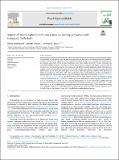Por favor, use este identificador para citar o enlazar a este item:
http://hdl.handle.net/10261/309175COMPARTIR / EXPORTAR:
 SHARE SHARE
 CORE
BASE CORE
BASE
|
|
| Visualizar otros formatos: MARC | Dublin Core | RDF | ORE | MODS | METS | DIDL | DATACITE | |

| Título: | Impact of starch-hydrocolloid interaction on pasting properties and enzymatic hydrolysis |
Autor: | Santamaría, María CSIC ORCID; Garzón, Raquel CSIC ORCID ; Rosell, Cristina M. CSIC ORCID | Palabras clave: | Alpha-amylase Digestion Kinetic constant Rapid viscoanalyzer Viscosity |
Fecha de publicación: | 10-abr-2023 | Editor: | Elsevier | Citación: | Food Hydrocolloids 142: 108764 (2023) | Resumen: | Hydrocolloids are extensively used for food processing because their techno functional properties (emulsifier, stabilizer, and structural agent). But there is increasing interest in their role connected with nutritional improvements, particularly related to starch hydrolysis rates, which might involve the viscosity resulting from starch-hydrocolloid interaction. The objective of this research was to investigate the impact of gels viscosity on the enzymatic hydrolysis of a range of starch gels made with different starches and hydrocolloids. Heterogeneous systems (starch-hydrocolloid) were prepared with several starches (corn, wheat, rice, potato, cassava, pea) and hydrocolloids (locust bean gum, guar gum, xanthan gum, hydroxypropylmethylcellulose K4M, psyllium) at different concentrations (0%–0.5% - 2.5%). The starch-hydrocolloid pasting behavior and their susceptibility to amylase hydrolysis was recorded with the Rapid Viscoanalyzer following a rapid method (Santamaria, Montes, Garzon, Moreira, & Rosell, 2022a). The viscosity decay due to alpha-amylase activity was modeled to obtain starch gels hydrolysis rate (k). A negative correlation was found among kinetic constant (k) and viscosity at 37 °C (r = −0.55), setback (r = −0.50), and area under the pasting curve (r = −0.42). For instance, xanthan gum and psyllium addition showed strong negative correlation between kinetic constant and viscosity at 37 °C (r = −0.75) and setback (r = −0.79), respectively, particularly when blended with potato starch. These correlations indicate that pasting properties of the starch-hydrocolloid systems might be predictors of the enzymatic digestion rate of the gels, allowing the design of foods with controlled postprandial glucose response. | Versión del editor: | https://doi.org/10.1016/j.foodhyd.2023.108764 | URI: | http://hdl.handle.net/10261/309175 | DOI: | 10.1016/j.foodhyd.2023.108764 | ISSN: | 0268-005X |
| Aparece en las colecciones: | (IATA) Artículos |
Ficheros en este ítem:
| Fichero | Descripción | Tamaño | Formato | |
|---|---|---|---|---|
| Food Hydrocolloids2023-Santamaria.pdf | Artículo principal | 2,45 MB | Adobe PDF |  Visualizar/Abrir |
CORE Recommender
SCOPUSTM
Citations
5
checked on 06-may-2024
WEB OF SCIENCETM
Citations
3
checked on 22-feb-2024
Page view(s)
44
checked on 07-may-2024
Download(s)
79
checked on 07-may-2024
Google ScholarTM
Check
Altmetric
Altmetric
Este item está licenciado bajo una Licencia Creative Commons



